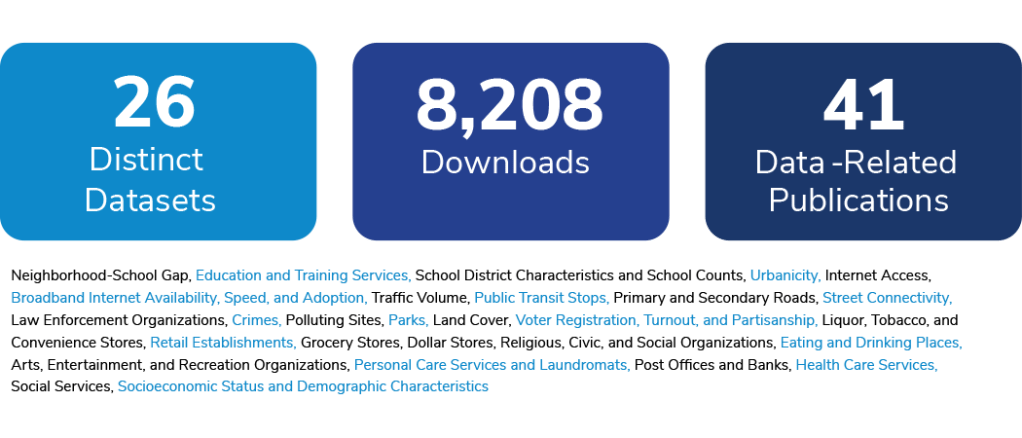A national neighborhood data resource to understand inequities in the health and socioeconomic impacts of COVID-19 in the United States
Principal Investigator

Philippa Clarke
Professor, University of Michigan Institute for Social Research
Principal Investigator

Grace A Noppert
Research Assistant Professor, University of Michigan Institute for Social Research
Co-Investigators
- Jessica Finlay, Postdoctoral Research Fellow, University of Michigan Institute for Social Research
- Carina Gronlund, Research Assistant Professor, University of Michigan Institute for Social Research; Research Assistant Professor of Epidemiology, School of Public Health, University of Michigan
- Amy Pienta, Associate Research Scientist, Inter-University Consortium for Political and Social Research, University of Michigan
- Ketlyne Sol, Research Investigator, University of Michigan Institute for Social Research
- Marilyn Sinkewicz, Research Investigator, University of Michigan Institute for Social Research
Funded By
The problem:
The COVID-19 pandemic did not impact all neighborhoods equitably. While some of these inequities can be attributed to differences in mitigation policies, mask usage, and vaccine uptake, these factors don’t offer a complete explanation. Neighborhood characteristics present before the pandemic began undoubtedly contributed to differences in the health and socioeconomic impacts of COVID-19.
To gain a comprehensive understanding of the COVID-19 pandemic, it’s crucial to examine how neighborhood characteristics influenced various outcomes—from immediate concerns like disease transmission to long-term consequences like community-wide economic challenges. Identifying these attributes can shed light on why pandemic outcomes differed by location and help us understand which factors increased or decreased risk for individuals and communities.
The approach:
The National Neighborhood Data Archive (NaNDA) is a publicly available database of the built, physical, and social environment across the entire United States. The archive contains longitudinal neighborhood data for multiple spatial scales—including census tract, ZIP code, and county—dating back to 1990.
The archive’s 26 distinct datasets share measures like access to parks, access to broadband internet, voter registration, and more. The research team creates these data resources, and the Inter-university Consortium for Political and Social Research (ICPSR) curates the data, making it accessible to a network of 750-plus academic institutions and research organizations and the public. The data set can be linked with existing clinical or cohort studies, surveys, and electronic health records. The aim: to support innovative social, behavioral and economic research on COVID-19, including risks related to COVID-19 infection and its downstream consequences.
The findings:
In three ways, researchers are creating novel measures and new data sources for COVID-19 social, behavioral, and economic studies.
First, University of Michigan researchers are enhancing the nation’s neighborhood data infrastructure by updating existing measures and adding new pandemic measures. The aim: to measure inequities in infection risk, physical distancing, and resilience. New 2020 measures include: the density of essential workers and essential businesses in neighborhoods; police presence and fatal and non-fatal police encounters in neighborhoods; and local LGBTQ+ related laws and policies relevant for understanding inequities in COVID-19 outcomes, housing, and economic security. Updated measures include socioeconomic disadvantage and affluence, internet accessibility, access to healthcare and social services, and other measures that may have an effect on infection risk, physical distancing, and resilience.
Second, the team funded pilot projects that will advance innovative neighborhood measures relevant for health equity:
- a nonprofit organization, the Movement Advancement Project, is using pilot grant funds to develop and publish data about neighborhood LBGTQ+ political climate, and
- researchers from the University of South Carolina are using artificial intelligence to measure neighborhood accessibility for wheelchair users by analyzing Google street view data.
Third, the newly launched COVID Neighborhood Project (CONEP) will build a national dataset with spatially-referenced COVID-19 case data. Currently, the team has data from 21 states at the ZIP code or census tract level. CONEP data is linked with data from NaNDA so we can understand what features of the neighborhood environment might tell us about the ways in which COVID-19 has affected certain neighborhoods.

Infographic “The National Neighborhood Data Archive is a publicly available data archive containing measures of the physical, economic, demographic, and social environment. At the time of the SBE CCC 2023 conference, it had:”. The infographic has three circular groups responding to the title with, “26 Distinct Datasets,” “8,208 Downloads,” and “41 Data-Related Publications.” Below the infographic are descriptions of some of these numbers in black and blue text, including information such as “Neighborhood-School Gap,” “Traffic Volume,” “Post Office and Banks,” “Health Care Services,” “Liquor,” “Parks,” “Crimes,” and other data.
Selected Publications & Presentations
Noppert, G. A., Duchowny, K. A., & Clarke, P. J. (2022). Declining US life expectancy since covid-19—structural inequities foreshadow future fallout. BMJ, o2249. https://doi.org/10.1136/bmj.o2249
Noppert, G. A., Clarke, P., Hoover, A., Kubale, J., Melendez, R., Duchowny, K., & Hegde, S. T. (2024). State variation in neighborhood COVID-19 burden across the United States. Communications Medicine, 4(1), 36. https://doi.org/10.1038/s43856-024-00459-1
Rollings, K. A., Noppert, G. A., Griggs, J. J., Melendez, R. A., & Clarke, P. J. (2023). Comparison of two area-level socioeconomic deprivation indices: Implications for public health research, practice, and policy. PLOS ONE, 18(10), e0292281. https://doi.org/10.1371/journal.pone.0292281